Peacock is the correct name for a male peafowl, while peahen is correct for females. Because of the male’s incredible iridescent beauty, we tend to refer to males and females as peacocks.
Whether you use the correct names or not, there is no denying that peacocks (or peafowl) are among the most spectacular birds on the planet!
Peacocks feel right at home in a warm climate, so they naturally have a better capacity to resist heat. While this is an incredibly positive result of their evolution, it does not mean they can be left without support and attention during the hot summer months.
Keep reading to learn what peacocks need when temperatures rise and how you can help them.
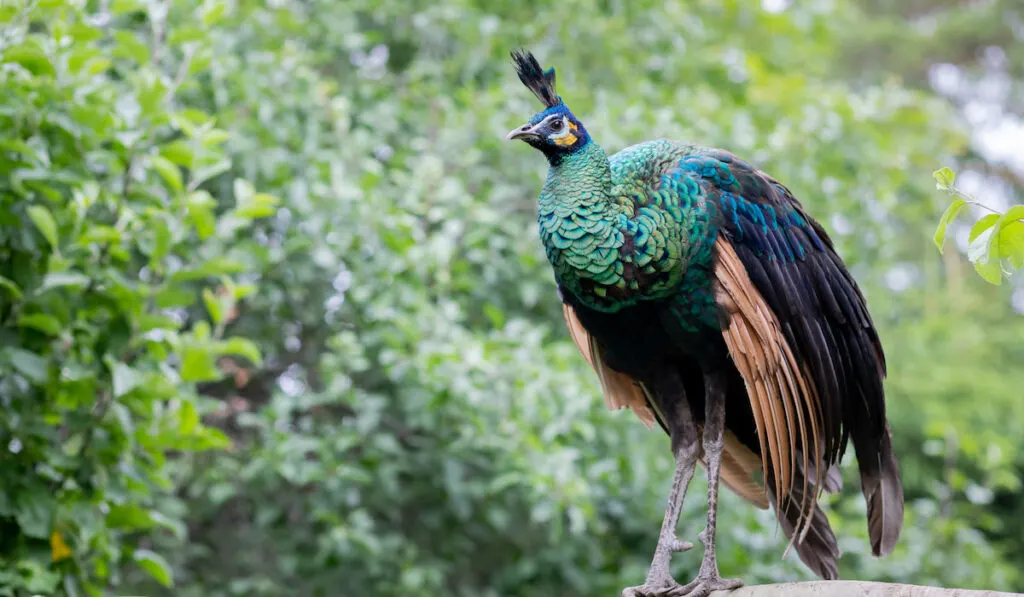
Table of Contents
Is It True That Peafowl Can Survive in Very Hot Weather?
Two well-known species of peacock are the blue peacock, which is native to Sri Lanka, and the green peacock, which is native to Myanmar and the Indonesian island of Java. The Congo variety is the third most common type of peafowl and originates in the jungles of Africa.
Peacocks thrive in the warm, wet conditions of the tropics. Their preferred habitat is a dense tropical rainforest with a reliable water supply throughout the year, so they can congregate in large flocks and enjoy roosting in trees.
The weather in most forests on the equator is always hot and humid. The average temperature in tropical rainforest regions ranges from 68 to 84°F (20 to 28.8°C), and never dips below 64°F (17.7°C)!
Even though the weather in tropical rainforests is always hot, the temperatures never get as high as in drier parts of the equatorial belt. This is due to abundant cloud cover, which helps reduce the average number of sunshine hours per day to between four and six.
Still, the high humidity levels in the air are usually over 50% during the day and close to 100% at night, making the heat seem very intense.
Peacocks use their surroundings to minimize incoming solar radiation. The climate is regulated because the plants and trees of the rainforest act like a giant parasol. For the peacocks to survive, they need access to all-season water sources.
If you have peacocks, ensure you provide plenty of shade and water while the temperature rises in the enclosure under your watch.
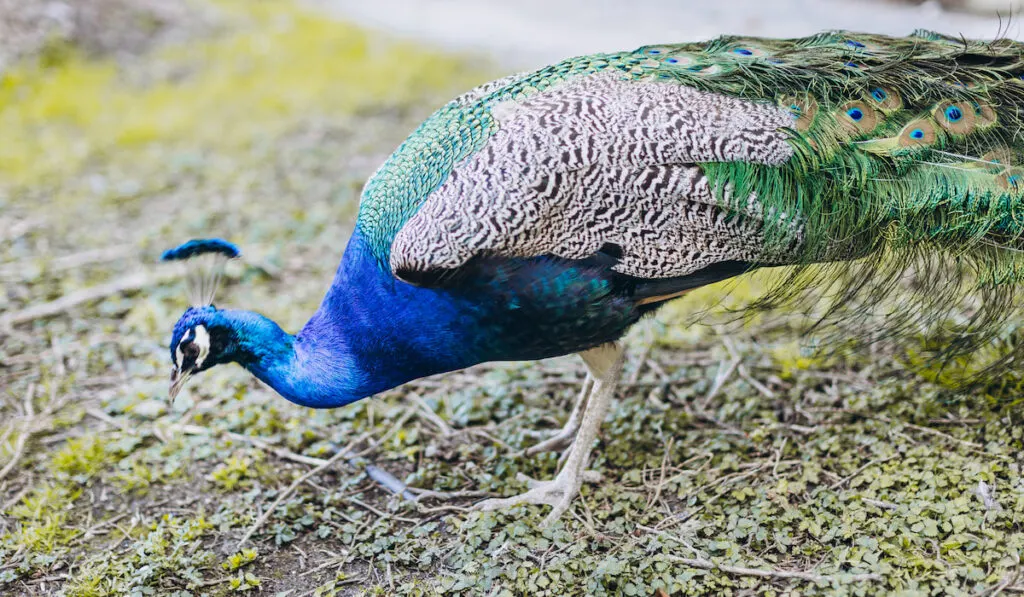
How Do Peacocks Cool Themselves Down?
Peafowls don’t have sweat glands like other animals, so they have to find other ways to stay cool.
Birds can survive in extremely hot conditions by employing various strategies that use their natural surroundings and body traits.
Birds release excess heat through the bare skin on their legs, feet, wattles, or comb, by finding shaded areas and breathing rapidly.
Panting
When a bird breathes, it takes quick breaths that move air over its moist lungs and throat. Water evaporates as a result and removes heat from the bird’s body. Some of its body heat is released every time the bird breathes out, making it feel slightly colder.
Fluffing the Feathers
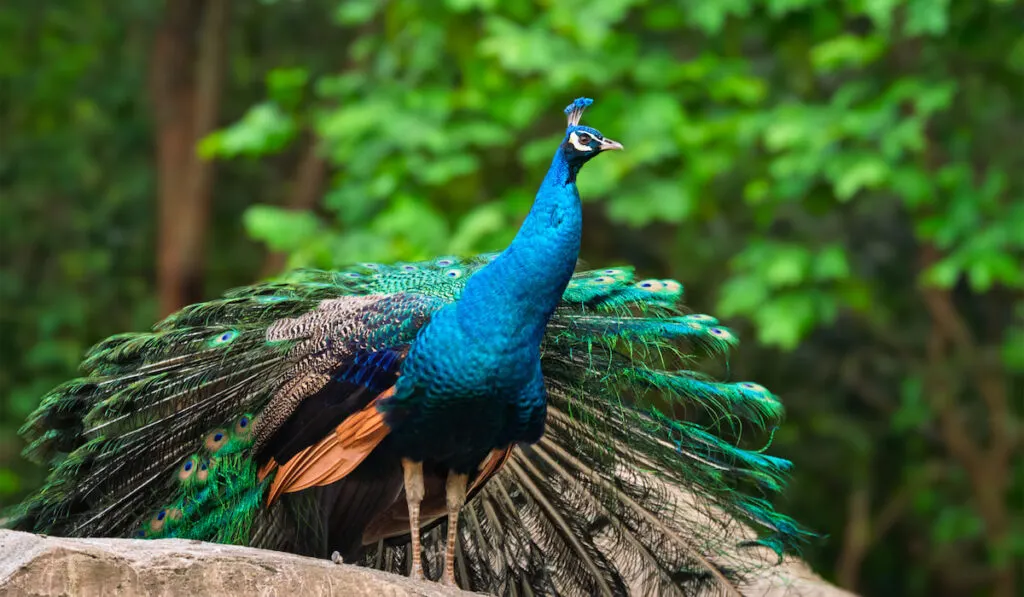
Peafowls lift their feathers and spread their wings so air can get to their skin and take away some of their body heat.
Contact of the body with cooler surfaces
Touching cooler surfaces allows peafowls to reduce their body temperature. In warm weather, they like to burrow into moist, chilly soil.
Prevent overheating
During the heat, peafowls spend a lot of time resting quietly in the shade to prevent overheating.
Symptoms of a Peacock Overheating
- Panting
- Putting out its wings and fluffing up its feathers
- Drinking more water and eating less than usual
- Being weak in body
- Drooping
- Lethargic
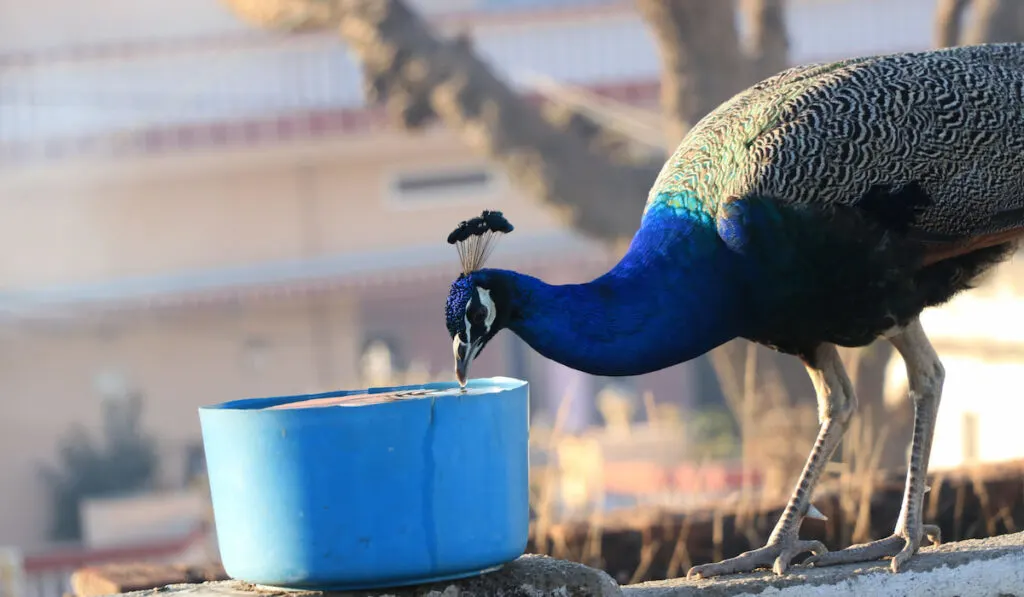
1. Water
Peacocks originated in the rainforest, and the tropical jungle naturally has plenty of water sources. Remember that water is one of the essential factors for peafowl during hot weather.
To keep peacocks healthy, you must provide them with plenty of clean, cool water.
Your peacocks will need their water dishes refreshed several times a day. Stinky, stagnant water isn’t good for your birds’ health, and it might make them sick if they drink it.
A water feeder or watering nipple is a simple solution for preventing water contamination and spilling. Cleaning and managing the water supply using watering equipment is also less hassle.
Don’t hang water feeders for peacocks. Peafowl can experience wing damage if entangled in the line or wire used to hang a water feeder.
The water can be kept chilled for longer by adding ice cubes. Or, if you’re using large troughs to serve water, you can keep the temperature down by placing frozen water bottles inside.
You can ensure that your peacocks never go thirsty if you give them various water sources in shady, cool spaces.
2. Electrolytes
Electrolyte therapy helps peafowls deal with the negative effects of heat stress.
Birds raise their respiratory rate in hot conditions to cool off. However, vital electrolytes are lost through heavy panting.
Peafowl can’t keep their fluid balanced without these electrolytes. Therefore, it is necessary to provide the flock with electrolytes and water to prevent dehydration.
These electrolytes are necessary for the peafowl to retain water. So, in addition to water, electrolytes should be given to the flock to keep it hydrated.
You can either purchase an electrolyte supplement or DIY using some common kitchen products.
Electrolyte supplements for purchase:
- Sav-A-Chick, Vitamins & Electrolytes
- Durvet, Vitamins and Electrolytes for Poultry
DIY recipe for the electrolyte solution:
- 3/4 gallon of water
- Eight spoonsful of sugar
- Half a teaspoon of salt, table salt, or sea salt
- Half of a teaspoon of baking soda
Provide electrolytes by following the manufacturer’s instructions and consulting your veterinarian before trying a home remedy.
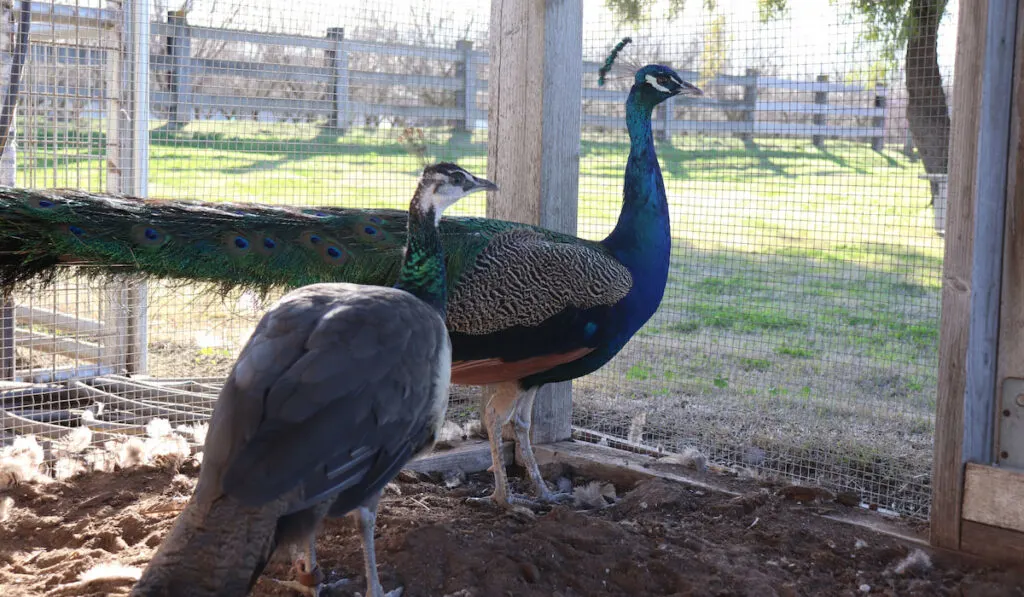
3. Water the Pen
Use a garden hose to spray water over your peacock’s pen to reduce the ambient temperature. It would be ideal if you could do it several times during the day, but you should give it a shot at least twice a day on particularly hot days.
Water the soil first thing in the morning or last thing at night to keep it moist for as long as possible, rather than in the middle of the day when it will quickly evaporate.
Having as much grass as possible in the bird’s run is also a good idea. Grass keeps water longer and is cooler than bare ground.
4. Mist
To reduce the heat in the aviary, a mister is an excellent purchase.
You can buy single or multiple standalone misters that attach to a garden hose or install a more complex, permanent misting system.
Sprinklers in a permanent misting system may be operated automatically and configured to activate at specific times of day or night.
When it comes to beating the heat, misters are a fast and reliable solution. The mist can quickly decrease the temperature by as much as 30 degrees!
The mist created by sprinklers gives the peacocks a much-needed break from the heat while imitating the humid, muggy conditions of the rainforest where they are originally from.
As a bonus, your peacocks can also take a relaxing mud bath.
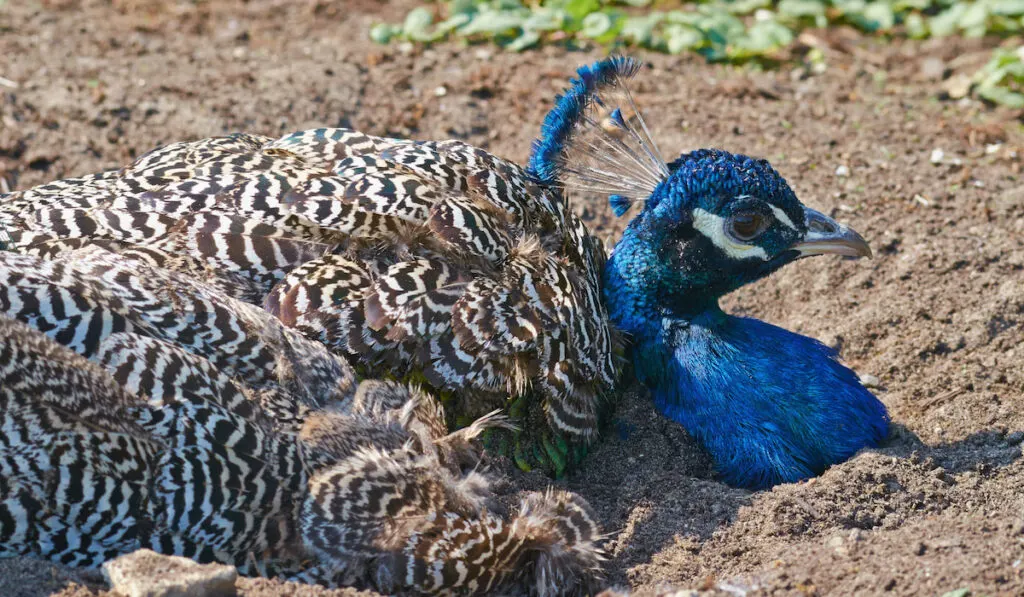
5. Dust Bath
When a peafowl comes into contact with a cooler surface, its body temperature drops.
Peafowls dig into the wet, cool earth when they want to take a dust bath. This is one sure method that birds generally use to relax, cool down, regain strength, and energy.
It’s important to provide a particular location in the peacocks’ aviary for them to burrow into the dirt, preferably in a shady place or several different places to ensure space for the whole flock.
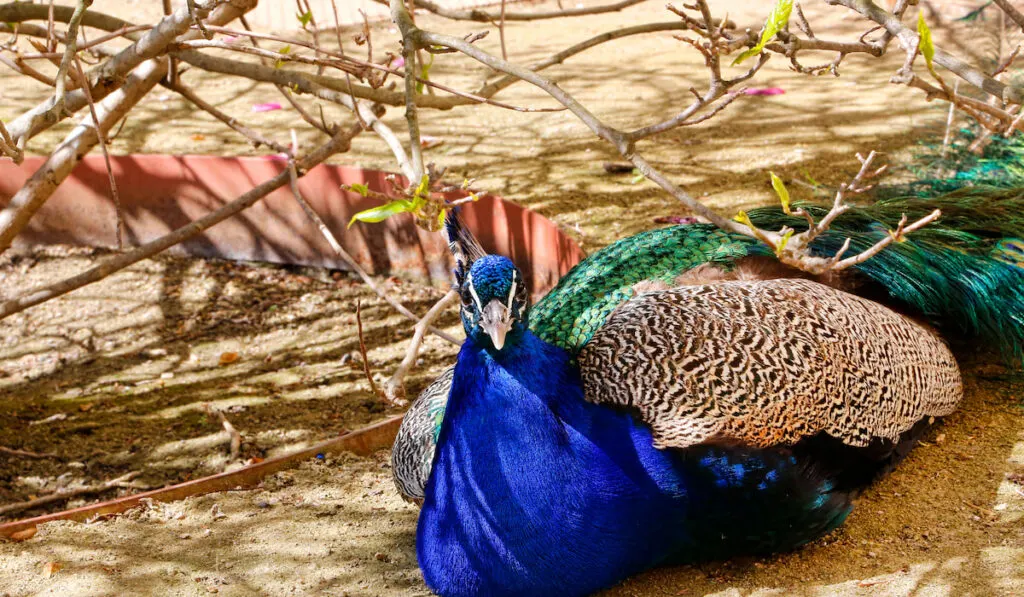
6. Shade
During the hot summer months, shade is just as important as water. At all times of the day, the peafowl must have access to sufficient shade to keep them cool.
Shrubs and trees planted within the enclosure can provide peafowls with natural protection from the sun. That’s the simplest answer and the closest to how things work in nature.
But if you can’t give the birds access to natural plant cover, you will need to come up with an alternative approach.
To make deep shadows easily, you just need to stretch a large piece of dark fabric over a few sets of posts.
You might also try to build a shady structure for your peacocks. If you do this, you’ll have a long-lasting shelter that your birds can use for several seasons and on rainy days all year round.
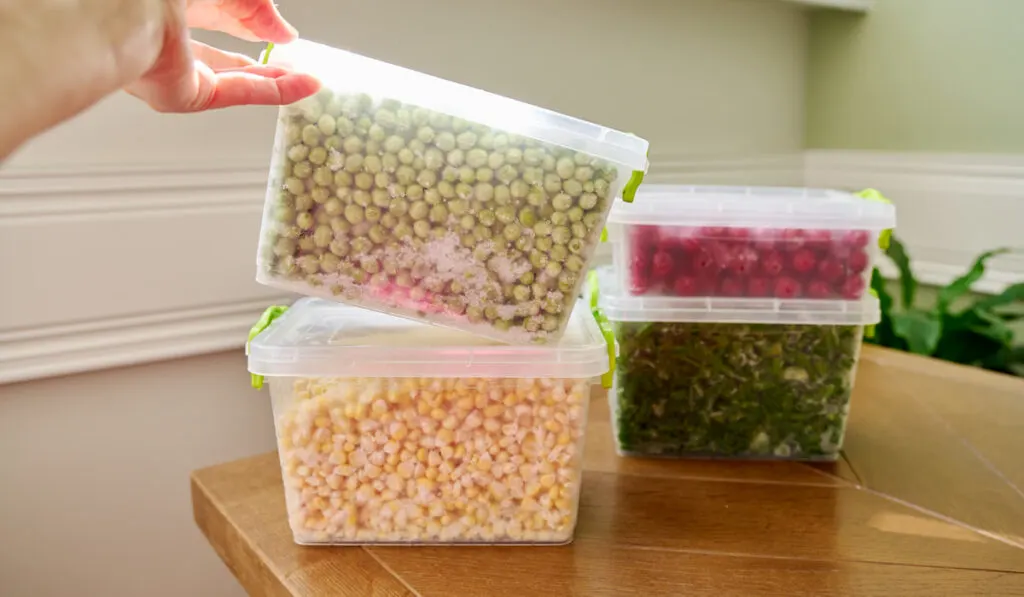
7. Cooling Snacks
Peacocks love a diet rich in leafy greens, fruits, herbs, and even some types of flowers. So why not take advantage by using them to cool down your peacocks when it’s hot outside?
It won’t take you long to whip up some nutritious, refreshing snacks.
Cut some fruits, veggies, or herbs and pop them in the freezer for a few hours.
Spread the frozen treats around the aviary or drop them into water containers.
Here are some suggestions for healthy fruits, vegetables, and herbs that you can use:
- Papaya
- Watermelon
- Cabbage
- Sweetcorn
- Peas
- Broccoli
- Grapes
- Pineapple
- Parsley
- Basil
- Kale
- Berries
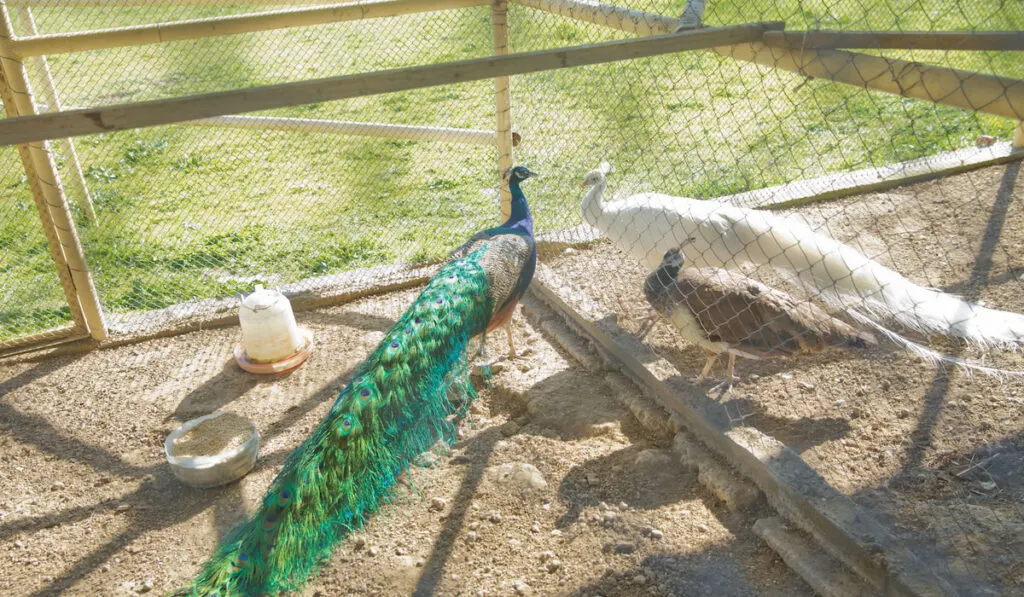
8. Avoid Overcrowding
Too many peacocks in a small area will raise the ambient temperature while also raising each peacock’s body temperature.
To provide the ideal living conditions for your birds, you must follow a few criteria when determining how much room you will need for your flock. Remember that peafowls are larger than most birds and require more space.
Pen Space
Peacocks require roughly 100 square feet of floor space per bird.
Full-grown peacocks can reach lengths of nearly 6 feet (1.8 meters)! Fencing should be at least 6 to 7 feet (1.8 to 2.1 meters) high and provide enough space for each peacock to roam freely.
Remember that peacocks thrive in groups of five or six adults, so you need a sizable pen.
Coop Space
As a general rule of thumb, a single peacock needs a coop space measuring at least 10 feet by 10 feet (3 meters by 3 meters).
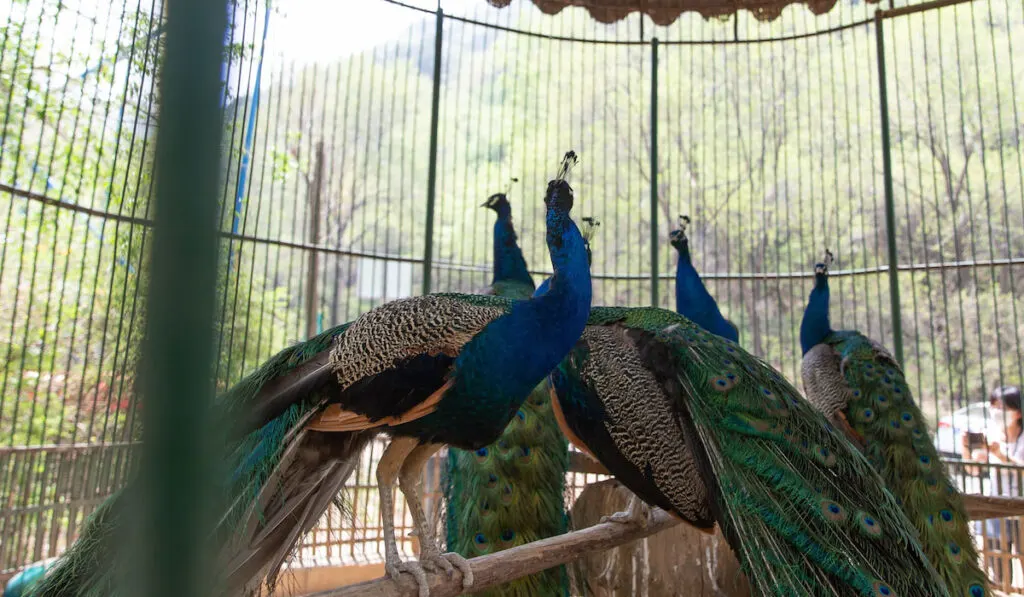
9. Ventilation
Without proper ventilation, a coop can rapidly become unbearably hot and stuffy.
Ensure there are many windows, vents, and other openings in the coop to let in cool air during the warmer months. A decent rule of thumb for sizing ventilation in a coop is one square foot per 10 square feet of floor space.
If you find your vents’ natural airflow insufficient, install some fans in your coop to help keep the temperature down.
Final Thoughts
Peacocks are tropical forest-dwelling birds. Even though they have an inherent natural tolerance to heat and perform better in the heat than other poultry, you must provide them with heat-resistant settings.
Imagine a dense tropical jungle. Many animals and birds benefit from its protection. Huge trees offer shade from the sun, and a steady water supply is available thanks to the humid environment and regular rainfall.
That’s just what your peacocks require in the heat. If you provide plenty of shade and water, and if you add delicious cold snacks, they will be both happy and healthy.
Resources
- https://wagwalking.com/bird/condition/overheating
- https://en.wikipedia.org/wiki/Peafowl
- https://www.joyofanimals.com/where-do-peacocks-live/
- https://www.britannica.com/place/Republic-of-the-Congo/Climate
- https://www.britannica.com/science/tropical-rainforest
- https://blog.nwf.org/2010/08/nature-qa-how-do-birds-stay-cool-in-the-summer/
- https://www.themarthablog.com/2020/07/my-peafowl-in-summer.html
- https://www.cacklehatchery.com/6-tips-for-raising-peafowl/
- https://farmhouseguide.com/fruits-and-vegetables-for-peacocks/
- https://jualayamhias.com/peacocks-eat/
- https://www.vincent.wa.gov.au/agenda/2013/20130312/att/004.pdf
- https://animals.mom.com/build-peacock-coop-9191.html
- https://plusvet.eu/2022/05/03/electrolyte-therapy-essential-during-heat-stress/
- https://www.wood-enterprises.com/70savachickvande.html
- https://www.drugs.com/vet/vitamins-electrolytes-for-poultry.htm
- https://www.thefeatherbrain.com/blog/how-much-coop-ventilationl
